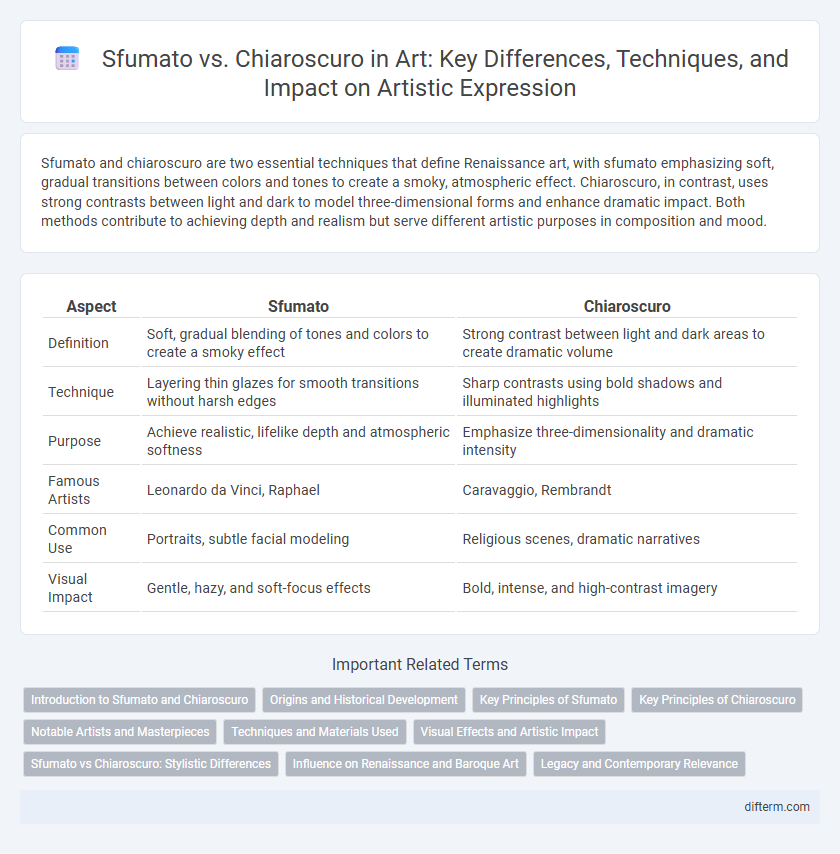Sfumato and chiaroscuro are two essential techniques that define Renaissance art, with sfumato emphasizing soft, gradual transitions between colors and tones to create a smoky, atmospheric effect. Chiaroscuro, in contrast, uses strong contrasts between light and dark to model three-dimensional forms and enhance dramatic impact. Both methods contribute to achieving depth and realism but serve different artistic purposes in composition and mood.
Table of Comparison
| Aspect | Sfumato | Chiaroscuro |
|---|---|---|
| Definition | Soft, gradual blending of tones and colors to create a smoky effect | Strong contrast between light and dark areas to create dramatic volume |
| Technique | Layering thin glazes for smooth transitions without harsh edges | Sharp contrasts using bold shadows and illuminated highlights |
| Purpose | Achieve realistic, lifelike depth and atmospheric softness | Emphasize three-dimensionality and dramatic intensity |
| Famous Artists | Leonardo da Vinci, Raphael | Caravaggio, Rembrandt |
| Common Use | Portraits, subtle facial modeling | Religious scenes, dramatic narratives |
| Visual Impact | Gentle, hazy, and soft-focus effects | Bold, intense, and high-contrast imagery |
Introduction to Sfumato and Chiaroscuro
Sfumato is a painting technique characterized by the delicate blending of colors and tones, creating soft transitions without harsh outlines, famously used by Leonardo da Vinci. Chiaroscuro involves the strong contrast between light and dark to give the illusion of volume and depth, prominent in the works of Caravaggio and Rembrandt. Both techniques enhance realism but employ different methods: sfumato relies on subtle gradations, while chiaroscuro emphasizes dramatic lighting effects.
Origins and Historical Development
Sfumato originated during the Italian Renaissance, credited primarily to Leonardo da Vinci, who developed this technique to create soft transitions between colors and tones, enhancing the realism and depth in portraiture. Chiaroscuro, with roots in the late 15th century, evolved through artists such as Caravaggio and Rembrandt, emphasizing stark contrasts between light and shadow to achieve dramatic volume and emotional intensity. Both techniques significantly influenced Baroque and Renaissance art, shaping visual storytelling by manipulating light to create mood and dimensionality.
Key Principles of Sfumato
Sfumato is characterized by the delicate blending of colors and tones to create soft transitions without harsh edges, achieving a smoky, atmospheric effect. This technique emphasizes subtle gradations of light and shadow, enhancing depth and realism while allowing forms to emerge gently. Key principles include the gradual layering of translucent glazes and precise control over light diffusion to mimic the natural softness of human skin and atmospheric perspective.
Key Principles of Chiaroscuro
Chiaroscuro is a technique emphasizing strong contrasts between light and dark to create the illusion of volume and depth in two-dimensional art. It relies on dramatic shading to enhance the three-dimensionality of forms and direct the viewer's focus within the composition. Mastery of chiaroscuro involves precise control of lighting to achieve a realistic portrayal of shadows and highlights, distinguishing it from softer transitions seen in sfumato.
Notable Artists and Masterpieces
Leonardo da Vinci is renowned for pioneering sfumato, evident in masterpieces like the Mona Lisa and The Virgin of the Rocks, where subtle gradations of tone create a soft, smoky effect. Caravaggio exemplifies chiaroscuro with dramatic contrasts between light and dark, highlighted in works such as The Calling of Saint Matthew and Judith Beheading Holofernes, intensifying emotional impact. Rembrandt combined both techniques skillfully, using chiaroscuro to emphasize figures while employing sfumato for smooth transitions, as seen in The Night Watch and Self-Portraits.
Techniques and Materials Used
Sfumato employs delicate layers of translucent oil glazes to create smooth gradations between colors and tones, producing a soft, hazy effect without harsh outlines, famously utilized by Leonardo da Vinci. Chiaroscuro relies on strong contrasts between light and dark, achieved through bold application of oil paints and strategic shading to enhance volume and three-dimensionality in a composition. Both techniques necessitate meticulous brushwork and mastery of oil mediums, but sfumato emphasizes subtle tonal transitions while chiaroscuro prioritizes dramatic illumination.
Visual Effects and Artistic Impact
Sfumato creates a soft, gradual transition between colors and tones, producing a smoky, atmospheric effect that enhances the perception of depth and realism. Chiaroscuro employs strong contrasts between light and dark areas, intensifying drama and highlighting volume to evoke emotional tension. Together, these techniques manipulate light and shadow to engage viewers and convey complex artistic narratives.
Sfumato vs Chiaroscuro: Stylistic Differences
Sfumato and chiaroscuro are distinct techniques that manipulate light and shadow to achieve different artistic effects. Sfumato, characterized by soft, gradual transitions between tones, creates a hazy, atmospheric quality often used to convey subtlety and depth, as famously demonstrated in Leonardo da Vinci's "Mona Lisa." In contrast, chiaroscuro employs stark contrasts between light and dark to produce dramatic intensity and three-dimensionality, exemplified in works by Caravaggio and Rembrandt.
Influence on Renaissance and Baroque Art
Sfumato, characterized by soft, gradual transitions between tones, significantly influenced Renaissance art by enhancing the naturalism and depth of portraits, notably in Leonardo da Vinci's works. Chiaroscuro, with its stark contrasts between light and shadow, became a defining technique in Baroque art, intensifying drama and emotional impact as exemplified by Caravaggio's paintings. Both techniques advanced the representation of three-dimensionality, shaping the evolution of Western art during their respective periods.
Legacy and Contemporary Relevance
Sfumato, perfected by Leonardo da Vinci, revolutionized portraiture through its soft gradations and subtle transitions, influencing Renaissance and modern realist artists. Chiaroscuro, characterized by dramatic contrasts of light and shadow, remains a critical technique in contemporary visual storytelling and digital art, enhancing depth and emotional intensity. Both techniques continue to shape artistic expressions, bridging classical mastery with innovative practices in painting, photography, and cinematography.
Sfumato vs chiaroscuro Infographic

 difterm.com
difterm.com